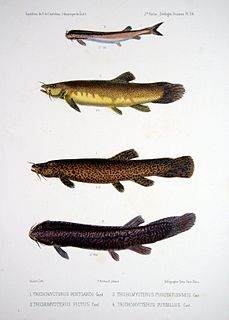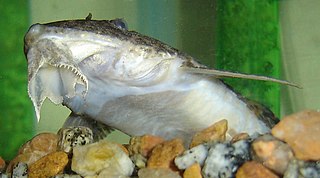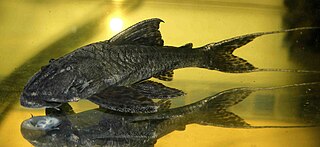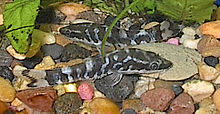
Loricariidae is the largest family of catfish, with 92 genera and just over 680 species. Loricariids originate from freshwater habitats of Costa Rica, Panama, and tropical and subtropical South America. These fish are noted for the bony plates covering their bodies and their suckermouths. Several genera are sold as "plecos", notably the suckermouth catfish, Hypostomus plecostomus, and are popular as aquarium fish.

Hypostomus is a genus of catfish in the family Loricariidae. They are native to tropical and subtropical South America. H. plecostomus is the popular freshwater aquarium fish formerly known as Plecostomus plecostomus. There is a lot of confusion as to the precise taxonomic structure of the Loricariidae.

Corydoras is a genus of freshwater catfish in the family Callichthyidae and subfamily Corydoradinae. The species usually have more restricted areas of endemism than other callichthyids, but the area of distribution of the entire genus almost equals the area of distribution of the family, except for Panama where Corydoras is not present. Corydoras species are distributed in South America where they can be found from the east of the Andes to the Atlantic coast, from Trinidad to the Río de la Plata drainage in northern Argentina. Species assigned to Corydoras display a broad diversity of body shapes and coloration. Corydoras are small fish, ranging from 2.5 to 12 cm in SL., and are protected from predators by their body armor and by their sharp, typically venomous spines.

Otocinclus is a genus of catfish in the family Loricariidae native to South America, commonly known as "dwarf suckers" or "otos". This genus, like other loricariids, is characterized by rows of armour plating covering the body, as well as the underslung suckermouth. They are generally small in size; O. tapirape is the smallest of the species (2.4 cm), while O. flexilis is the biggest (5.5 cm). These species have adaptations that allow them to breathe air. A duct forms at the junction between the esophagus and the stomach and expands into an enlarged, ring-like diverticulum, characteristic of this genus, which allows air-breathing. Otocinclus are popular aquarium fish, and they are often purchased as algae eaters. It is difficult to breed them in captivity, and only wild caught Otocinclus are available to hobbyists. This genus is widely distributed east of the Andes of South America, throughout the lowlands from northern Venezuela to northern Argentina, but are generally absent from the Amazon and the Orinoco lowlands.

Trichomycteridae is a family of catfishes commonly known as pencil catfishes or parasitic catfishes. This family includes the candiru fish, feared by some people for its alleged habit of entering into the urethra of humans. They are one of the few parasitic chordates. Another species is the life monsefuano which was important to the Moche culture and still an important part of Peruvian cuisine.

The Pimelodidae, commonly known as the long-whiskered catfishes, are a family of catfishes.

The golden otocinclus is one of the smallest known suckermouth catfish, often called a 'dwarf oto'. Endemic to Southeast Brazil, this herbivorous, rheophilic, bottom-feeder only grows to around 4 cm (1.6 in) in length. The close relatives of this small fish are often used for the purpose of controlling algae in small home aquariums, under the name Otocinclus affinis. In reality, they belong to the species O. vittatus, O. vestitus and O. macrospilus. The real M. affinis is not present in the aquarium hobby.

Baryancistrus is a genus of freshwater Loricariid catfish. They inhabit flowing sections of rivers, especially clearwater, in the basins of the Amazon and Orinoco in Brazil and Venezuela. The largest species reach up to 34 cm (13 in) in total length.

Rineloricaria is a genus of freshwater tropical catfish belonging to the family Loricariidae. They are commonly called whiptail catfish because of the long filament that grows out of the tip of the caudal fin that is characteristic of the genus. With the exception of R. altipinnis from Panama, they are native to the rivers of northern and central South America. Some species are regularly seen in the aquarium trade.

Hemiancistrus is a genus of suckermouth armored catfishes. These species are native to South America. The taxonomy of this genus is complex and unclear, and major work has to be done. Many of these fish are popular aquarium fish.

Striped Raphael catfish is a catfish of the family Doradidae. It may also be called Southern striped Raphael, talking catfish, chocolate doradid, chocolate catfish or thorny catfish. It is native to the Amazon, Paraguay–Paraná and lower Orinoco basins in South America. This peaceful, nocturnal species is a popular aquarium fish due to its pleasant temperament and curious nature.
Ixinandria steinbachi is the only species in the genus Ixinandria of catfish of the family Loricariidae.

The Hypoptopomatinae are a subfamily of catfishes of the family Loricariidae, composed of 17 genera and approximately 80 species. This subfamily represents about one-tenth of all loricariid species.
Pseudotothyris is a genus of armored catfishes native to South America.
Harttia is a genus of armored catfishes native to South America.

Loricaria is a genus of armored catfish native to South America.
Neoplecostominae is a subfamily of South American catfishes of the family Loricariidae. Species of this subfamily live in high-mountain and swift-flowing river habitats.
Gymnotocinclus anosteos is a species of armored catfish (Loricariidae) endemic to Brazil, where it is found in the Tocantinzinho River in the Tocantins River basin. This species grows to a length of 4.4 centimetres (1.7 in) SL.
Pseudotocinclus tietensis is a species of armored catfish endemic to Brazil where it occurs in many tributaries of the upper Tietê basin. It is found both in small creeks and medium size rivers such as the Paraitinga River, a tributary of the rio Tietê, where it lives grazing on semisubmersed overhanging plants. It is also found in the Rio Grande, a small sized river which drains to the Billings Dam near Vila de Paranapiacaba, Santo André. This species can be found attached to the grass along the river margin and in the middle of the river among rocks and pieces of wood in fast current water. This species grows to a length of 6 centimetres (2.4 in) SL.
Otocinclus batmani is a species of armored catfish (Loricariidae) native to South America. It can grow up to 37 millimetres (1.5 in) (SL).














